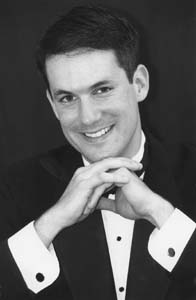![[MetroActive Music]](/music/gifs/music468.gif)
[ Music Index | Santa Cruz Week | MetroActive Central | Archives ]
Bold Colors, Hesitant Shading
Amid an otherwise moving symphony program of evocative works, conductor John Larry Granger fails to find mystery
By Scott MacClelland
SOME OF THE MAGIC in Ralph Vaughan Williams' Symphony No. 2 "London" remained hidden in shadows during the Santa Cruz County Symphony's performance Feb. 26. Conducting without a score, John Larry Granger led an orchestrally savory reading of the 50-minute, quasi-programmatic work, fulfilling the composer's design faithfully and with no small boldness. Although the hushed approach of sunrise at the start and the implicit fall of night at the conclusion nicely framed the muscled scherzo and marching andante, the second movement lento never quite captured its latent mystery, never got soft and imaginative enough to cast its spell.
In symphonic music, soft and slow remains the most elusive to conductors. It's where the camera looks for the closeup under low light, where the composer wants to be discovered despite the risk of intimate violation, a realm where Granger has often feared to tread, an artistic line he has resisted crossing. To argue that it's not in the score doesn't cut it; music notation is a crude language in the face of music performance, where matters of style and personal insight must complete the picture. In any case, Granger got good response from his solos in the movement, including Diane Machado-Wyant's cor anglais, Susan Vollmer's horn and Terry Schade's Salvador Dali viola.
Piano soloist for the program, Robert Thies won the 1995 International Prokofiev Competition in St. Petersburg. In Rachmaninoff's Rhapsody on a Theme of Paganini, Thies gave a clean, in-charge performance that tossed off the technical challenges with ease. The piece itself gives little opportunity to reveal the soloist's depth of artistic expression, and Thies made no attempt to find profundity in its pages--a wise decision. The popular 18th variation was straightforward and effective and only cried out for a larger string complement to fulfill the composer's desire for a full flood of sonority.
Aside from that, Granger's orchestra came through with strong colors and, in the austere acoustics, sharply etched effects.
The program opened with Australian composer Anne Boyd's Black Sun, "in memory of the Beijing students," a 10-minute tone poem that depicts events during the 1989 Tiananmen Square massacre. Boyd, ethnically Chinese, was teaching in Hong Kong at the time, and the juxtaposition of events in Beijing and the innocence of children singing in Hong Kong aroused her strongest emotions and an acute sense of urgency in completing a commission she had been offered by the Women's Philharmonic, which premiered the piece in 1990.
A pentatonic tune, "The Ancestor of the Dragon," became the germinal motive for Black Sun, which sighs in grief while being "invaded" by tanks and guns. In parading its different elements, often as discrete as they are descriptive, Boyd imitates much Chinese music for orchestra composed since the Cultural Revolution. These works, by all manner of contemporary Chinese composers, essentially revive the old tradition of descriptive tone poems. Witness the popular Yellow River piano concerto, Little Sisters of the Grasslands pipa concerto and Butterfly Lovers violin concerto. Although Boyd's work is grim and sorrowful, it gains credibility for delving into Chinese traditional ideas and musical techniques.
Granger's orchestra delivered the work luminously and with clarity, thrusting its angst and dissonance, pausing to savor its pentatonic allusions and tritones and ultimately lingering on its long-held closing meditation. The piece deserves more exposure, both for what inspired it and for Boyd's heartfelt but disciplined construction.
Copyright © Metro Publishing Inc. Maintained by Boulevards New Media.
![]()
 Technical Reading: Pianist Robert Thies, featured soloist with the Santa Cruz County Symphony, wisely didn't search for profundity in Rachmaninoff's 'Rhapsody.'
Technical Reading: Pianist Robert Thies, featured soloist with the Santa Cruz County Symphony, wisely didn't search for profundity in Rachmaninoff's 'Rhapsody.'
in subdued sections
From the March 1-8, 2000 issue of Metro Santa Cruz.